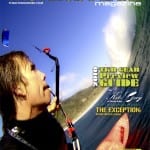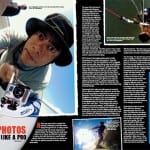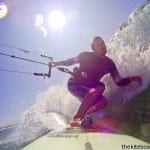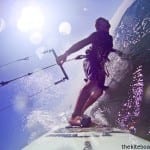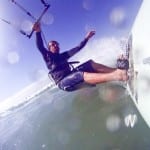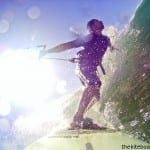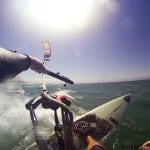Get the Most from Your GoPro
By Paul Lang
Originally Published in the December 2009 Issue of The Kiteboarder Magazine
Have you ever tried to explain the feeling of blasting across flat water, flying through the air, or riding waves to someone who has never experienced kiteboarding? The things that put week-long smiles on our faces are difficult to articulate to others, but with the help of a small digital camera that more and more kiters are using, you don’t have to explain yourself to others. You can show them.
{openx:86112}
The cover of the last issue of The Kiteboarder Magazine featured a unique picture taken by Brendan Richards from Caution Kites that made you feel as if you were right there riding that Northern California wave with him. Believe it or not, that killer point-of-view image was shot by a $159 waterproof digital camera. The camera Brendan used was the GoPro Hero Wide, a 5-megapixel camera that comes with a water housing and an assortment of different mounts to secure the camera to any number of surfaces. “They are great because of the fisheye, which allows you to take photos of yourself, even hand held,” said Brendan. “Of all the cameras I have worked with, it has the best wide-angle out of the box, and this makes it the only camera that is ideal for the average kiter who wants to capture themselves kiting.”
GoPro Cameras (www.goprocamera.com) currently manufactures two cameras they market as “wearable sports cameras.” They are essentially the same 5-megapixel camera that can either shoot stills or video, but with different lenses. The standard lens offers a 54 degree angle view, while the wide version serves up an amazing 170 degree angle of view. Both capture either still images or video and can be mounted virtually anywhere, but we’ve found that the Hero Wide is suited very well to capture unique point-of-view images and video of kiteboarding. I am 6′ tall, and the extremely wide angle of view on the Hero Wide allowed me to mount the camera to the nose of my 6’2″ surfboard and easily fit my whole body into the frame.
Mounted on a helmet, the video footage gives an incredibly realistic view of what kiteboarding looks and feels like. Even though GoPro makes and sells mounts to mount the GoPro in almost any situation they could come up with, they do not sell any products to easily attach the camera to your flying lines. Pacific Northwest kiter and photographer Jim Stingfellow has developed a GoPro mount specifically for kiteboarding. He calls it the Kite Hero (available at www.kitehero.com) and it quickly attaches the camera to your kite’s center lines. “I have designed this mount to be used on any front line system,” said Stringfellow. “It utilizes each front line for positioning and security, while still providing the safety of a front line flagging safety system. This mount works on many four-line systems including Best, Liquid Force, Slingshot CSS, Naish Smart Loop, and Eclipse bars. I have also used this on the Naish Shift system and the North Fifth Element bars.” This allows you to mount the camera in a unique place, just a few feet away from the rider. Check out Stringfellow’s website (www.jimstringfellow.com) for more sample photos and videos showing how to use the Kite Hero mount.
The old saying “You get what you pay for” definitely applies to photography equipment, so if you are getting a camera, housing, and mounts for less than $200, then you have to be giving up something compared with more professional equipment. With the GoPro, you are giving up a screen to easily review images on and also having to settle for image quality that is only average. Without an LCD screen to review images, it’s impossible to see what the images will look like until you plug the camera into a computer. This isn’t really a big deal, but it does create a challenge when you are testing out a new angle and you cannot immediately see the results. The images and video that the GoPro creates are great for online use, but they are not ideal for print, even though we have used images captured by the GoPro in this magazine. With that said, at a price of $159, the GoPro gets you the most bang for the buck compared to any other options for taking a camera out on the water while kiteboarding. The unique shots that you can capture with this camera by placing it in unique places that you would not even attempt with other cameras more than makes up for its average performance.
{openx:86112}
GoPro now also offers an upgraded model, the GoPro HD Hero. The Kiteboarder was given a sneak peak at some preproduction test footage from the new camera, and we were absolutely blown away by the quality. The HD Hero retails for $299, and you will be able to use this camera to record professional-looking video of yourself out on the water. If you have friends that don’t really understand what it is about kiteboarding that is so exciting, put together a little video or a few photos with a GoPro camera. It will make them understand why you get nutty every time the wind blows.
TIPS:
- Photos taken with the sun behind the camera will look much better than with the camera looking into the sun.
- Look into the camera when doing a trick, no one cares what the top of your head looks like!
- When you press the shutter button to start taking pictures or recording video, look at the display on the camera to make sure you actually started it.
- Brendan Richards captured last issue’s cover shot by simply holding the camera in his hand and pushing the shutter button at the opportune time. This method is for advanced riders only, but can allow you to take a photo at just the right moment instead of it possibly being missed by the camera’s two- or five-second interval timer. Use a camera leash if you try this!
- Pull your board shorts down once you start riding. None of your friends want to see 400 photos of your white thighs.
- When you are working your way upwind, stop taking photos or recording video if the camera is easily accessible. Many short video clips are much easier to edit into something cool to look at than one really long clip.
- Whatever mount you use, make sure the camera is rock solid, as the GoPro does not float!
Resources:
www.goprocamera.com
www.kitehero.com
Sample GoPro Wide Video Footage shot by The Kiteboarder Magazine:




